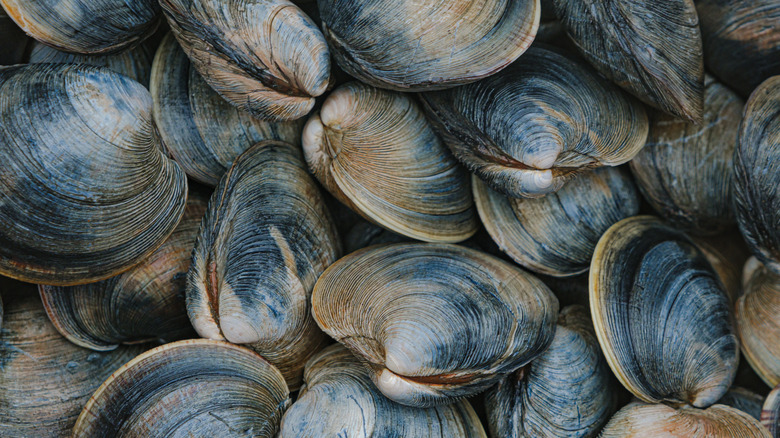The Truth About Eating Clams That Don't Open During Cooking
Clams are a tasty and nutritious shellfish that can be used in a variety of dishes, from creamy New England clam chowder to seafood linguine. However, if you've ever noticed a clam whose shell didn't open during the cooking process, it's best to chuck it in the trash to avoid the potential for foodborne illness. While this may feel wasteful, taking the precaution could protect you or your family from becoming sick.
While there are many signs to look for that indicate seafood may not be up to standard, there is a simple way to ensure you are purchasing quality clams. Clams are a bivalve mollusk, which means they have two shells that open and close via a hinge. Most clams will have their shells shut tightly, but if any of them are open, give them a tap. When touched, living clams will close their shells to protect themselves. To guarantee freshness, you must purchase and cook clams that are still living. So, do the tap test before buying to ensure the clams are alive. If you tap an open clam and the shell doesn't close, do not purchase it. The cooking process will kill the clam and cause their muscles to relax and their shells to open. Clams that remain shut after being cooked indicate that the clam was already dead before cooking. Dead clams start to decompose quickly, making them susceptible to bacterial growth that can lead to food poisoning and no one wants that.
Ensuring your clams are safe to eat
There are many mistakes you can make when buying seafood, so be sure you familiarize yourself with best practices before getting started. An important first step is to ensure you are purchasing clams from a reputable supplier, such as a high quality seafood market or grocery store. Avoid buying frozen seafood in bulk, as you don't know how fresh it was or how it was handled before freezing. Besides performing the tap test on clams with open shells, you should avoid any clams that have an overly fishy smell or broken shells. It's best to cook and eat clams as soon as possible after buying them. If you must wait a day or two, store them in a breathable container under a damp cloth, and consume within a day or two. Do not store live clams in an airtight container, as this can suffocate them, rendering all of them unsafe to eat.
To be extra cautious, check your clams again before cooking to make sure none of them died during storage. If you notice any of them have open shells, do the tap test once more and discard any that don't close. Steam or boil them until most or all of the shells have opened, and of course, toss any that remain closed. While it may seem like a tedious task, prying open a clam that didn't open during cooking is not worth the risk of illness.

